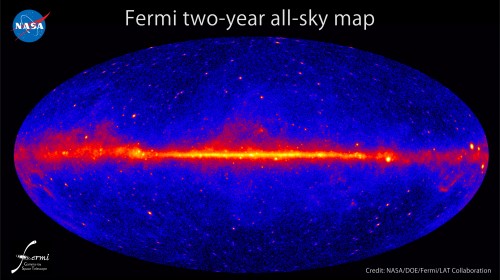
This all-sky image, constructed from two Fermi datasets, shows how the gamma-ray sky appears at energies greater than 1 GeV. (Courtesy: NASA/DOE/Fermi/LAT Collaboration)
By Calla Cofield at the APS April Meeting in Savannah, Georgia
The American Physical Society (APS) April meeting has been taking place in Savannah, Georgia, for the past three days. On Saturday, Tracy Slatyer from MIT spoke to reporters about a paper that she and colleagues posted on arXiv in February, in which they suggest that a mysterious excess of gamma rays surrounding the galactic centre could be explained as dark-matter particle annihilation.
The researchers use what Slatyer calls a “simple” model of dark matter, in which the invisible substance is made up of weakly interacting massive particles (WIMPs) with a mass of about 35 GeV. The model predicts that WIMPs may collide with each other and annihilate, producing gamma rays and either b-quarks or some other mixture of quarks. The Fermi Gamma-ray Space Telescope surveys the entire observable sky for the presence of gamma rays. Fermi’s observation of the plane of the Milky Way revealed that our galaxy is bright with gamma rays, but Fermi has not been able to identify the sources of all those powerful photons. Gamma-ray excesses (more than can be explained by known sources) near the galactic centre have been identified in the Fermi data in the past – most notably at about 130 GeV.
The work presented by Slatyer and her colleagues identifies an excess of gamma rays between 1 and 3 GeV. The researchers say they can see a distinctly spherical, bubble-like collection of photons. Slatyer told reporters that based on the dark-matter model, this spherical shape is not a coincidence – the dark-matter annihilation theory does not hold for a more stretched-out, elongated cluster of gamma rays; nor would it hold if the bubble were not at the centre of the galaxy.
“It looks spherically symmetric and centred on the galactic centre; its overall amplitude and the rate at which it falls off from the galactic centre are consistent with the predictions of dark-matter annihilation,” says Slatyer. “It’s definitely not a statistical fluctuation, and it seems unlikely that it’s a simple mismodelling of the diffuse background because if it were, there would be no reason that it would be spherically symmetric.”
One crucial step in identifying this gamma-ray bubble is making cuts to the Fermi data. The Fermi telescope collects high-energy photons and then reconstructs their path through the universe, ideally providing information about where the photon originated. The Fermi collaboration recently released a new parameter that ranks each photon by the quality or confidence of that reconstruction. Slatyer and her colleagues cut the bottom 50% of the data points based on this parameter, thus preserving only the data with the best path reconstruction. The result is a picture of the galactic plane that appears noticeably sharper than the image containing all of the data points.
Slatyer says that more evidence is needed to confirm that the gamma-ray excess is, in fact, the result of dark-matter annihilation. One additional piece of evidence would be observing the same phenomenon around the centre of another galaxy, most likely one of the dwarf galaxies near the Milky Way. While Slatyer is not a member of the Fermi collaboration, she was part of an independent team that first identified Fermi bubbles, also using the publicly available data from the Fermi telescope.
“I’m wary of saying it is physically impossible to have an astrophysical explanation for this signal. And the cleanest way to get round this is to see the signal somewhere else,” she says. “The dwarf galaxies and places that we expect to be very dark-matter dominated, we expect to see very low background. I think that would be very strong evidence.”
More energetic than the cosmic gamma photons, there should exist dark photons and Planck photons. Also, similar to the cosmic microwave background radiation (CMB), there should exist a ‘cosmic dark photons background’ (CDB). Dark photons may be the particles of the elusive dark matter. http://vixra.org/pdf/1303.0207v3.pdf